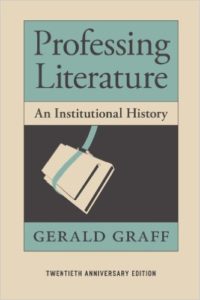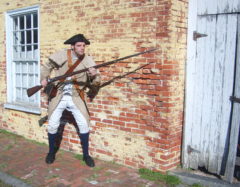Graff, Gerald. “The Promise of American Literature Studies.” Professing Literature: An Institutional History. Chicago: University of Chicago Press, 1987, pp. 209-25. Print.

Graff’s chapter, “The Promise of American Literature Studies,” primarily focuses on common debates among literary scholars in the early and middle portions of the twentieth century. At the forefront of the debate is the rise of the NEW CRITICISM, which is defined as the process of reading a work of literature as an aesthetic object independent of historical context and as a cohesive whole that reflects the cohesive sensibility of the artist (Brewton). According to Graff, some scholars felt that American literature should seek to merge with American history, a sentiment that had been shared by myriad people throughout the course of America’s history (210). Nevertheless, the New Criticism sought to alter these stale perceptions, and this fresh method of criticism began to gain momentum after WWI.
As noted in previous annotations related to American literature’s history, early American literature functioned primarily as a political or religious tool, so numerous educated individuals in the eighteenth and nineteenth centuries believed that American writings should remain associated with the country’s political and religious history. Essentially, many Americans did not see their country’s literature as literary; therefore, some influential educators defended American literature with minimal praise or apologized for it, yet they did not see artistic value in it (Graff 212). As Thomas P. Miller purports, from the mid-1700s, the establishment of new colleges and expansion of print contributed to more individuals being introduced to literature, and this shaped college English studies (57). Even with new perspectives and the ability to reach a wider audience, the patriotism associated with the literature was immense. This patriotism actually hindered literature’s impact aesthetically and delayed its implementation as a professional field of study for many years (Graff 213).
Graff continues his chapter by examining how proponents of the New Criticism of the early and middle twentieth century tinkered with theoretical methodologies. According to Graff, theorists like Winters, Maule, and Matthiessen were the “first to apply the methods of the New Criticism to American literature, and in their hands—more than in other field, I believe—the New Criticism became a historical and cultural method” (217). These scholars allowed America’s history to play a role in literary study through the culture epitomized in fictional works; for example, these critics looked at symbolism in romantic works of literature, and they applied these symbols to Puritan and other historical and cultural roots found in early America. In fact, these types of thematic and historical connections can still be found today when opening some high school English textbooks.
When opening a high school text, I find Jonathan Edwards’s sermons just a few pages away from Arthur Miller’s Crucible. Certainly these works are connected historically through the content and themes surrounding Puritans; however, in reality, these works have little in common structurally, stylistically, and chronologically. As many scholars of the twentieth century began to realize, New Critical processes were just incorporating everything; however, under the surface many critics realized that the same authors and stories were consistently being examined by the New Criticism, and works from the Revolutionary period were being ignored because they did not fit the new critical scheme (Graff 221). Eventually, as Graff notes, NEW HISTORICISTS established a break, and this critical turn allowed for the progression of other theories and criticisms, like the feminist approach, to gain steam and look at how history and culture have influenced writing (221).
Additional Sources:
Brewton, Vince. “Literary Theory.” Internet Encyclopedia of Philosophy. IEP and its Authors, 2016, www.iep.utm.edu/literary/. Web. Accessed 23 September 2016.
Miller, Thomas P. The Evolution of College English: Literacy Studies from the Puritans to the Postmoderns. Pittsburgh: University of Pittsburgh Press, 2011. Print.
